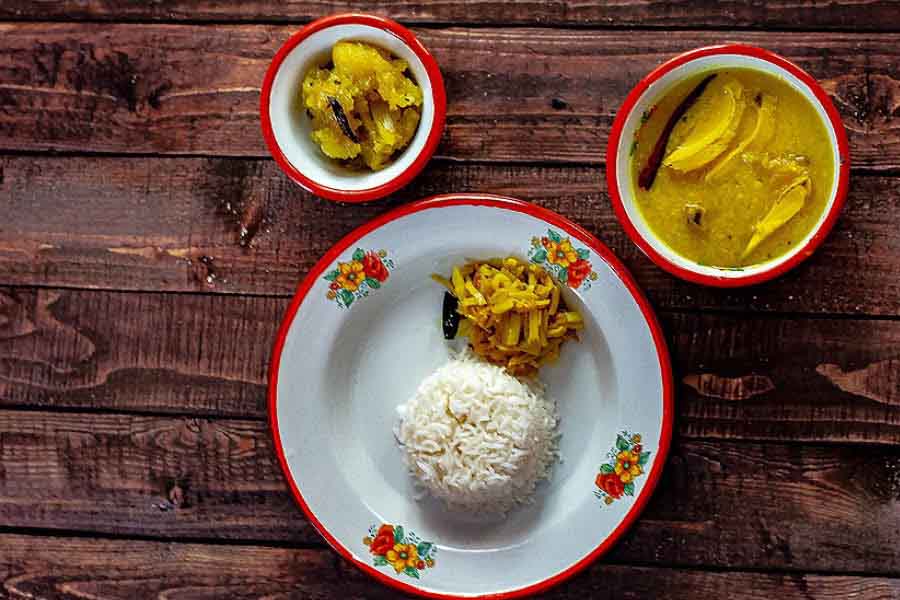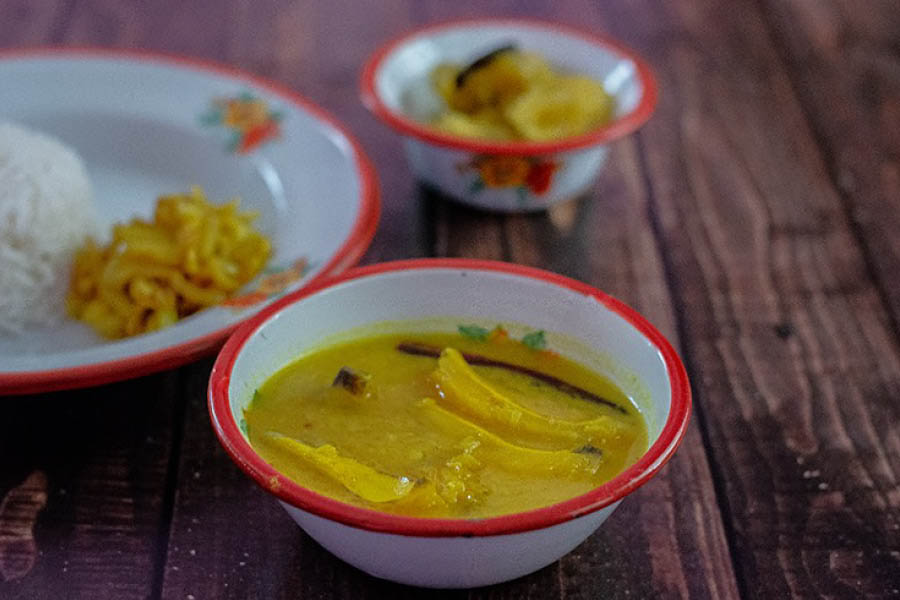Come summer and I find myself digging into my regular comforting dose of aam dal with bhaat whenever I have a Bengali meal.
I have never been a regular dal-bhaat eater in my day-to-day meals, nor do I pack rice and accompaniments for office lunch. I prefer eating my typical Bengali meal in the comfort of home, even if it is just once a week. So, it is essentially on weekends, when I am free from the daily routine, that I indulge in a home-cooked Bengali meal loaded with seasonal delicacies. In summer, aam dal is a must.
A summer staple

A simple platter comprising bhaat, ‘aam dal’ and aloo bhaja
In summer, maa always made it mandatory for us to have tawk dal, as we call this light and flavourful lentil soup cooked with green mangoes. There is no escaping the seasonal dishes that are believed to have beneficial properties, considering there is a tigress-like mother at home. At 40, I feel I have no way to escape her responsibility to guide me towards healthier and natural food habits.

'Aam dal 'is light and has cooling properties from green mangoes, which we need in the humid weather of West Bengal Shutterstock
I have always seen the emphasis on seasonal dishes, cooked with local produce at home. My maa, jethima, and the matriarchs of the family were very particular about respecting the ingredients that are available only in certain seasons. Aam dal, for sure, is no exception. Growing up, I learnt this light dal has cooling properties from green mangoes, which we need in the humid weather of West Bengal. This is probably the reason why, at my place, aam dal is cooked with red lentils or masoor dal, instead of motor dal or arhar dal, to make it light and comforting. The tempering is also simple — just a spoonful of mustard seeds and dry red chilli. However, there are ample recipes available for aam dal, where green mango remains a fixed ingredient, but the choice of dal and tempering varies from family to family. In ours, a spoonful of sugar is a must. In a nod to my Ghoti lineage, we prefer our aam dal to hit a note somewhere between sweet and sour.
Adding the right spices
Moong dal or arhar dal makes aam dal a bit heavier. I have seen people cooking tawk dal with a mixture of masoor and moong, too. In West Bengal, though, it is usually masoor dal that is used for making aam dal. Though not popular these days, there was a time when even aam dal used to be prepared separately for widows using arhar dal. I have seen my dida cook her portion separately for herself, as she strictly refrained from having masoor dal ever since my grandfather’s passing. As for tempering, panch phoron and mustard seeds are used interchangeably. However, the version cooked with arhar dal calls for cumin seeds as tempering.
Winning a place of pride

Have you tried making ‘aam dal’ this season?
The tigress (read maa), whose aam dal I have grown up savouring, continues to make it a regular item on her summer lunch table, oblivious to the inclusion of this humble delicacy to the 26 best-rated dishes with mangoes compiled by Taste Atlas, which describes it as ‘a traditional dish originating from India, made with mango and lentils as key ingredients’. Neither the delightful aamer aachar nor the classic aam pora shorbot, but the ordinary, basic Aam Dal had won this pride of place. I had to inform her, and I did. Isn’t that enough occasion to celebrate the simplicity and beauty of this Bengali seasonal delicacy?
Here’s the recipe for aam dal that I follow for the readers of My Kolkata to celebrate summer and the comfort of Bengali cuisine.
Aam dal recipe
Ingredients
- Red lentil (masoor dal): 100g
- Green mangoes: 2pc
- Mustard seed for tempering: 1tsp
- Dried red chilli for tempering: 2tsp
- Green chilli: 1pc
- Salt: 1tsp
- Turmeric powder: ½ tsp
- Sugar: 3tsp
- Mustard oil: 2tbsp
Method
- Remove the stems from the green mangoes and cut them into slices after discarding the skin as well as the seed
- Cut the green chillies as well
- Wash the red lentil under running water at least 2-3 times
- Now take a pressure cooker and heat mustard oil in it. Temper the oil with mustard seed, followed by dry red chillies
- Add mango slices and cook for a minute after adding half-a-teaspoon each of salt and turmeric powder
- Once done, add washed red lentils and give a thorough mix
- Now add half a teaspoon of turmeric powder followed by 2.5 cups of water and give a thorough mix. At this point, add the green chillies as well as the sugar and adjust the salt as well. You can decrease the amount of sugar if you do not like tawk-mishti dal!
- Now put the lid on, along with the vent weight, and cook on medium flame till the pressure cooker releases pressure three times (three whistles)
- Once done, switch off the flame and let the pressure drop completely
- Serve aam dal at room temperature accompanied by steamed rice and with a side of either aloo chokha or aloo bhaja to indulge in the beauty of a comforting summer treat
Debjani Chatterjee Alam is a professional in corporate social responsibility. She is also the blogger behind ‘Debjanir Rannaghar’, where she has been sharing recipes for the past 14 years. Debjani also hosts occasional pop-ups to showcase her culinary skills.



